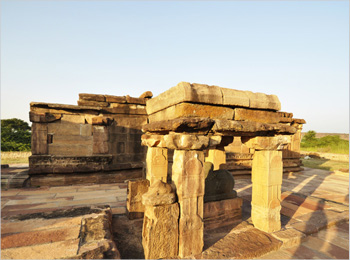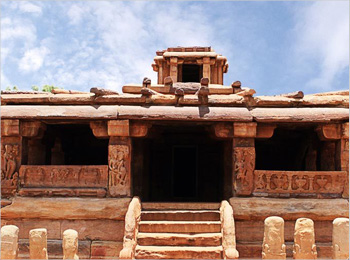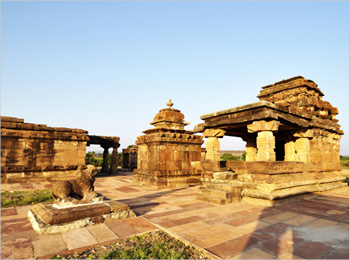- Shiva
Galaganatha Temple
- Aihole,Karnataka
- View on map
- Tell us about this temple
Overview
The Galaganatha Group of Temples is located in Aihole. It is on the banks of River Malaprabha in Karnataka. The temple is historically renowned and has over a hundred ancient temples all over the city. The temples are built in the Chalukyan style of architecture. High levels of architectural and sculptural skills of medieval India are rooted here. There are two prominent groups of temples in Aihole including Galaganatha Group of Temples and Kontigudi Group of Temples. Galaganatha Group has 38 small shrines of which only the Galaganatha Temple is intact. The rest are in ruins.
About The Temple

The gateway at the entrance to the Galaganatha Temple Group is noteworthy. Pillars are embellished with the pot and the foliage motif and the lintel is sculpted with foliated makaras. In Hindu mythology, makara, a mythical creature which is a water monster, is the vahana or vehicle of Ganga and Varuna. It is also the insignia of love god Kamadeva. The temples have a curvilinear shikara or spire about the Garba Griha or sanctum sanctorum, and images of the deities of Rivers Ganga and Yamuna at the entrance to the shrine. This is a typical feature of Chalukyan architecture. The Galaganatha Temple enshrining Shiva as a presiding deity. The huge temple is east facing and situated along River Tungabhadra. There is a huge Shiva Linga in a closed hall here which is known as Sparsha Linga. The basement of the temple is unusually pyramidal and there is a huge open hall. The gopura or tower is embellished with plain architectural elements but the wall panels at the back of the hall are adorned with remarkable decorations. There are numerous niches in the interior of the temple with figural sculptures including that of Lord Ganesha.
History of the Temple

The history of Galaganatha Group of Temples is in fact the history of Aihole, the cradle of ancient temple architecture. When Aihole was the Chalukyan capital, the rulers built over 125 temples in varying styles. The Chalukya king, Pulakesin II was an ardent follower of Jainism. During his reign, there was an architectural extravaganza not only at Aihole, but also in the regions of Badami, Pattadakkal and other places. In the 17th century, Aurangzeb annexed the Deccan and Aihole too came under Mughal rule. The Chalukya dynasty was ousted by their own district officers, the Rashtrakutas, in AD 757. Thus, gradually, Aihole became a part of the Bahmani and other local Muslim dynasties.The erstwhile name of Galaganatha was Palluni. The Galageshwara Temple of Shiva was built around the 11th century. It is recorded that Sri Venkatesh Galaganath, also known as Kadambari Pitamaha, used to worship here and wrote his novels at the Galageshwara Temple premises.
There is a large inscribed slab in the open hall of Galageshwara Temple dating from 1080 AD onwards. The date throws light on the era when the temple was constructed. From the inscription we can gather that the tradition of performing arts, including dance and music, was prominent during this time. Performing arts attained high levels of development in the 11th century AD. From an inscription of the Chalukyan king, Vikramaditya from Galagnath, we can infer that a certain Mokhari Brammayya was a musician of high order during this period.
Accessibility
The nearest airport is Belgaum which is 189 km from Aihole. There are regular flights toBelgaum from all major cities in the country. The nearest railway station is Bagalkot, which is 34 km from Aihole. There are several direct trains to Bagalkot from all major cities in the country. Aihole is connected by road to Pattadakal (17 kms), Badami (44 kms) and Bangalore (490 kms). Package tours are conducted every day from Bangalore during the tourist season. One can also use any road service from Belgaum city via Bagalkot to reach Aihole.
Temple Address
Galaganatha Temple Complex,
Aihole, Bagalkot, Karnataka,
India, Pincode – 587 124.
Significance
Devotees visit this temple to seek fulfillment of the following:-
- Salvation
- Wealth
- Relief from diseases
- Purchase of vehicles
- Gain Knowledge
Shlokas
Kailaasarana Shiva Chandramouli Phaneendra Maathaa Mukutee Zalaalee Kaarunya Sindhu Bhava Dukha Haaree Thujaveena Shambho Maja Kona Taaree
Meaning -Oh Lord Shiva who is seated on Mount Kailash, where the moon decorates his forehead and the king of serpents crown his head, who is merciful and removes delusion, You alone can protect me. I surrender to thee.
Aum Trayambakam Yajaamahey Sugandhim Pusti Vardhanam Urvaarukamiva Bandhanaath Mrutyor Muksheeya Maamritaat
Meaning -We worship the fragrant Lord Shiva, who has 3 eyes and who cultivates all beings. May He free me from death, for immortality, as even a cucumber is separated from its bond with the vine.
Timings
The temple is open from 08:00 am to 06:00 pm.
